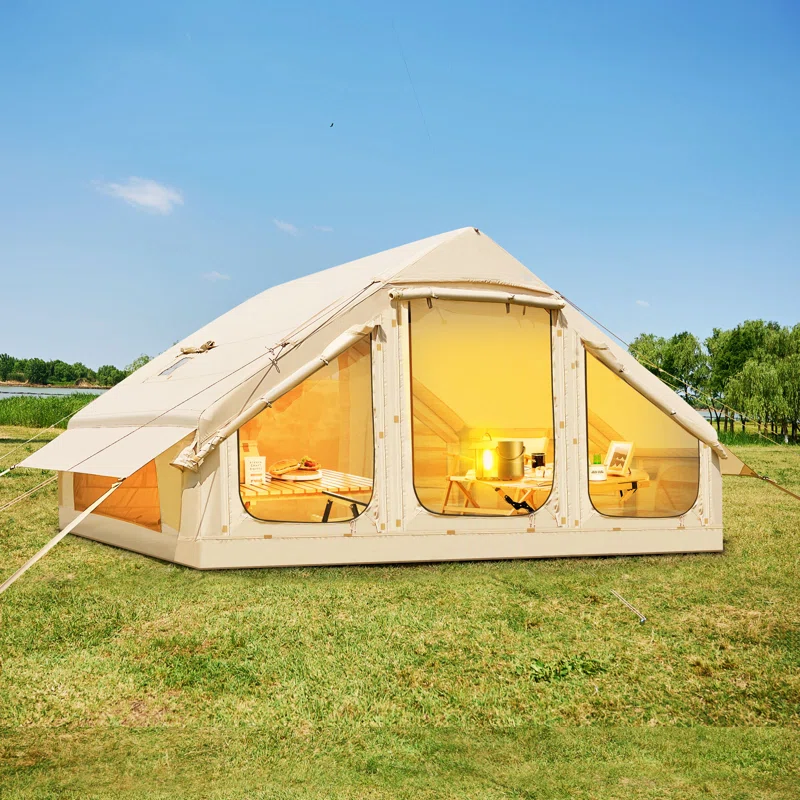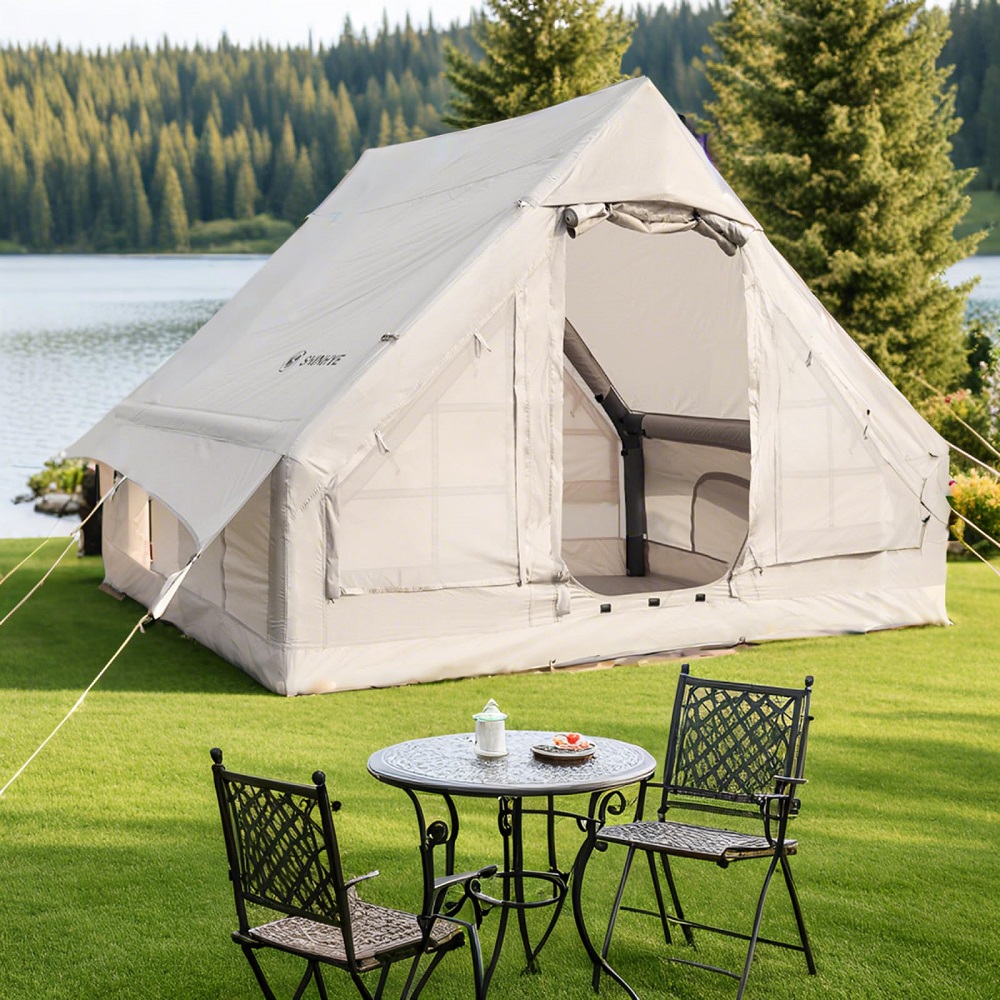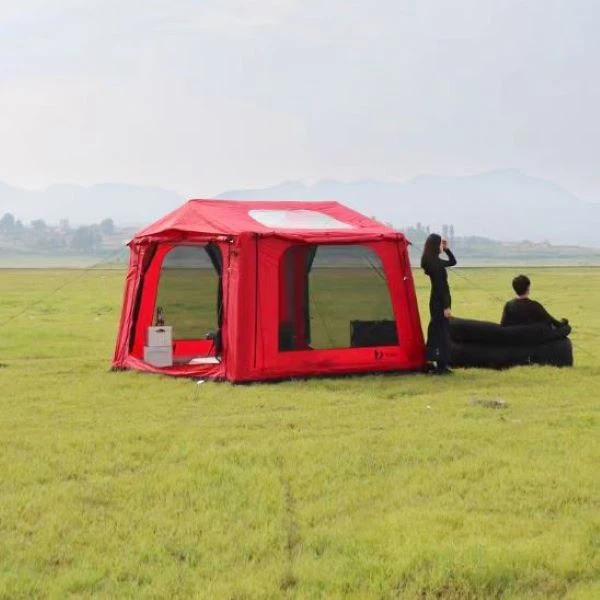History of Inflatable Camping Tents
The story of inflatable camping tents begins in the mid-20th century. Since their inception, inflatable camping tent have evolved significantly. Early models were basic and used rudimentary materials for construction. They were typically heavy and difficult to set up.
By the 1990s, advancements in material science allowed for lighter and more durable designs. These tents began to gain popularity among campers who cherished their ease of setup. Inflatable beams replaced traditional metal poles, reducing the overall weight and making transportation easier.
The turn of the millennium saw further improvements with the introduction of more rugged and weather-resistant fabrics. This era also marked a shift as inflatable camping tents started to integrate modern technologies.
Today, the inflatable camping tent market is rapidly evolving. Contemporary designs offer enhanced durability, weatherproofing, and environmental considerations. Companies are experimenting with new materials, aiming to create tents that are not just convenient but also long-lasting and sustainable.
Tent enthusiasts now expect high performance and comfort from their shelters. These expectations drive innovation in the field of inflatable camping tents. Forward-thinking designs tackle challenges like severe weather conditions and portability, shaping the future of camping.
In conclusion, the history of inflatable camping tents is a journey of innovation and adaptation. From bulky, cumbersome beginnings to sleek, technology-integrated models, they have come a long way. As we look towards the future, it’s clear that the inflatable camping tent will continue to adapt and improve, meeting the ever-changing needs of outdoor adventurers.

The Evolution of Materials and Durability
The materials used in inflatable camping tents have transformed dramatically. From the initial heavy and basic fabrics, we now see ultralight and robust synthetic materials. Durability has risen to the forefront of tent design, with the aim of creating tents that resist wear and tear over time.
Manufacturers have turned to advanced textiles like ripstop nylon and polyester with improved coatings. These coatings are designed to repel water and UV rays, extending the tent’s lifespan. Innovation has also led to the use of thermoplastic polyurethane (TPU), which offers superior puncture resistance and flexibility.
Another significant advancement is the seam technology. Seam taping and welding have replaced traditional stitching, providing stronger seals against the elements. This ensures that inflatable camping tents remain dry and intact in various weather conditions.
The quest for durability has also influenced the inflatable beams. Gone are the days of rubbery and fragile beams. Today’s tents employ reinforced beams that can withstand strong winds and minimize the risk of collapse.
Finally, research is ongoing to discover and integrate new materials that provide even greater durability. The goal is to craft inflatable camping tents that are both lightweight for the trekker’s ease and heavy-duty for long-term use. Each advancement paves the way for a new era of camping, where the focus is on longevity without compromising on convenience.

Technological Advancements in Inflation Mechanisms
Innovation has revolutionized the way inflatable camping tents are inflated. Traditional manual pumps have been overshadowed by new automated systems. These advanced mechanisms make setup a breeze, letting campers inflate their tents with minimal effort.
A key development is the electric pump, which has become more compact and efficient. Campers can now plug in their pump, press a button, and watch their tent inflate in minutes. Some models even offer wireless control, allowing inflation from a distance via a remote or smartphone app.
Furthermore, self-inflating tents are gaining traction. These tents harness built-in inflation technology. They expand themselves with just the twist of a valve. This innovation eliminates the need for any external pumping devices.
Built-in pressure sensors are another feature being integrated into inflatable camping tents. These sensors ensure the tent inflates to the perfect pressure level, avoiding overinflation that can lead to damage.
Moreover, designers haven’t overlooked eco-conscious campers. They’ve introduced solar-powered inflation systems, reducing reliance on electrical sources. These systems are both sustainable and convenient for remote outdoor settings.
To sum up, advancements in inflation mechanisms for inflatable camping tents make setting up camp fast, easy, and more enjoyable. With these technological improvements, campers can focus more on the adventure that awaits, rather than the setup of their temporary home.

Integration of Smart Technologies in Camping Tents
The world of inflatable camping tents is rapidly embracing smart technologies. With comfort and convenience in mind, manufacturers are integrating innovative features to enhance the camping experience.
Automated climate control is one feature that stands out. Tents can now maintain an optimal temperature, adapting to the surrounding weather conditions. This smart technology ensures that inside the tent is cool on hot days and warm during cold nights.
Interior lighting systems have also become smarter. LED lights are now controllable by remote or smartphone apps, allowing campers to adjust brightness or set mood lighting with ease.
Another leap forward is in connectivity. Tents equipped with Wi-Fi extenders or signal boosters help campers stay connected, even off the grid. This feature is perfect for those who want to share their adventures in real-time or need to stay in touch with work.
Security has been enhanced with the integration of alarms and location tracking devices to ensure campers’ safety. These systems can alert users to potential intruders or assist in finding the tent if they stray too far.
The introduction of voice-activated devices has also arrived in the inflatable camping tent market. Commands can now control tent features, offering hands-free convenience that was once only imagined.
Lastly, manufacturers are focusing on solar power solutions for charging devices, making it easier for campers to keep their gadgets powered without a traditional power source.
In summary, smart technology integration in inflatable camping tents is not just about gimmicks; it’s about adding genuine value to the camping experience. These technological enhancements make life easier, safer, and more enjoyable for modern campers.

Design Innovations for Extreme Weather Conditions
In the realm of inflatable camping tent design, extreme weather conditions present unique challenges. Manufacturers have been focusing on innovations to ensure the safety and comfort of campers under such demanding circumstances. Utilizing robust materials and incorporating smart design features has become a priority.
Enhanced Wind Resistance
Firstly, the structure of the tent has been reimagined to withstand strong winds. Aerodynamic shapes are now common, reducing wind resistance and preventing tents from collapsing or being blown away. The integration of sturdy, flexible beams adds to this resilience.
Improved Water-Proofing
Water-proofing has also seen significant advancements. Double-layered walls and reinforced flooring are designed to keep water out, even during severe downpours. Specialized coatings on tent fabrics repel water while remaining breathable, to prevent condensation buildup inside.
Temperature Regulation
Temperature regulation is another area of focus. The insulation of inflatable camping tents has been optimized with new materials that help retain warmth in cold environments, and reflect sunlight to keep cool in hot climates. Ventilation systems have been refined, ensuring a comfortable airflow.
Snow Load Management
Finally, designers have tackled the issue of snow load. They’ve engineered the roof pitches to allow snow to slide off, preventing the buildup that could cause collapse. The collective improvements in inflatable camping tents aim to protect campers, no matter how extreme the weather.

Eco-Friendly and Sustainable Inflatable Tents
Sustainability is key in today’s outdoor gear, including inflatable camping tents. Manufacturers prioritize the environment in their designs. They now offer tents made from recycled materials. These materials keep waste out of landfills and reduce the tents’ carbon footprint.
Eco-friendly tents use non-toxic, biodegradable fabrics. These less harmful options protect nature as campers enjoy it. Some tents also feature built-in solar panels. These panels harness energy from the sun, powering tent features without fossil fuels.
Dyes and treatments for tent fabrics have also gone green. They avoid harsh chemicals, safeguarding both campers and ecosystems. In production, techniques that save water and energy are becoming standard.
Inflatable camping tents with a ‘leave no trace’ design are a plus. These tents ensure minimal impact on camping sites. They feature raw materials that blend with the environment, stressing the importance of conservation.
In conclusion, eco-friendly innovations in inflatable camping tents are vital. They reflect a commitment to the planet and the future of camping. Each eco-conscious choice helps protect the destinations we love to explore.
Space-Saving Solutions and Portability Features
The inflatable camping tent has always offered some degree of portability. Yet, recent innovations have taken this to new heights. These tents are now more compact, easier to carry, and quicker to set up than ever before. Manufacturers are keen on designing tents for hikers and travelers who value ease of transport.
Compression and Storage Techniques
New storage solutions enable tents to pack down into incredibly small sizes. Advanced compression techniques remove excess air and decrease the bulk. This makes the tents fit into backpacks or even motorcycle pannaniers.
Lightweight Materials
The use of ultralight materials is pivotal in enhancing portability. These materials reduce the overall weight of the inflatable camping tent, making them less of a burden on long treks. They are also robust, ensuring that lighter doesn’t mean more fragile.
Multi-functional Design
Designers are creating tents that serve multiple purposes. Some inflatable tents can transform into other forms like windbreaks or shades. This adaptability means campers can pack fewer gear items. Every feature that can perform double duty cuts down on space and weight.
Portable Inflation Devices
To keep in step with the needs for mobility, inflation devices have shrunk too. Modern pumps are now smaller, lighter, and more efficient. Some are even built into the tent, reducing the gear needed for setup. This is a big win for campers who count every ounce.
Manufacturers understand the challenge of lugging gear into the wilderness. Their response has been to make inflatable camping tents one of the least of campers’ worries. With compact designs and innovative features, these tents make hitting the trails easier than before. They allow adventurers to focus on their journey, not the weight on their backs.
Safety Measures and Emergency Features in Inflatable Tents
The safety of campers is paramount, and inflatable camping tent manufacturers are on board. They’re innovating with emergency-ready designs. Safety measures now come built-in, ready for those unexpected moments nature throws your way.
Firstly, fire safety has improved. New tents have flame-retardant materials that resist ignition. This gives campers extra time to react if a fire breaks out. Smart alarms are also installed to warn campers of fire hazards early.
Structural stability is a focus, ensuring tents hold up under strain. Reinforced anchor points prevent tents from taking off in strong winds. They stay grounded, offering a safe haven whatever the weather.
Emergency exit designs have evolved. Quick-release doors and windows ensure a fast escape, if needed. These features are simple to use, even in low-visibility situations like at night or during storms.
Visibility is enhanced for safety too. Reflective materials make tents easy to spot from afar. This helps campers find their way back and rescuers to locate the tents quickly in emergencies.
Lastly, built-in storage for emergency kits makes them readily accessible. Campers can store safety gear where it’s easy to grab in a hurry. Inflatable camping tents now combine comfort with the critical peace of mind, aiming to keep campers safe as they explore the outdoors.
Community-Driven Design Innovations
Responding to Camper Feedback
The future of inflatable camping tents will also be shaped by community feedback and desires. As camping enthusiasts share their experiences through online platforms and social media, manufacturers will be better equipped to understand what features campers truly want. By exchanging ideas on forums or social media groups, campers can express their preferences regarding tent features, functionality, and style.
In 2025, we can expect brands to incorporate this feedback into their designs, leading to tents that better meet the needs and wants of real campers. This community-driven approach means that new models may offer enhancements based on collective voices, whether it’s a more spacious interior, additional storage pockets, or even aesthetic options in varied colors and patterns.
Collaborations with Outdoor Enthusiasts
Collaborations with outdoor enthusiasts and experts in the camping industry will also influence innovative designs. Manufacturers may partner with experienced campers, outdoor instructors, or environmental organizations to gather insights and to create tents that are not only high in quality but also environmentally sustainable.
These collaborations can also lead to special edition tents or unique features that address specific needs, such as tents designed for deep winter camping or those intended for family-friendly settings. Engaging the community in this way creates a more thoughtful and well-rounded approach to product design, which benefits everyone involved in the camping experience.
Embracing a New Era in Camping
The innovations and advancements in inflatable camping tents for 2025 signal an exciting future for outdoor enthusiasts. With user-friendly features, community-driven designs, and cutting-edge technology, the camping experience is set to evolve dramatically. Campers can look forward to more convenience, comfort, and functionality, all while enjoying the wonders of nature.
As more campers embrace these advancements, the camping community will grow. This growth fosters a deeper appreciation for nature and the outdoors. Ultimately, embracing these innovations means not just experiencing camping differently, but also sharing memorable adventures with friends and family, creating bonds that last a lifetime. The future of inflatable camping tents is bright, inviting everyone to explore and enjoy the great outdoors in style and comfort.
